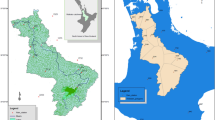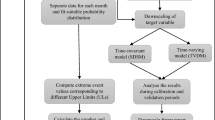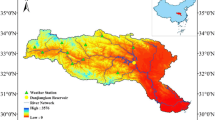Abstract
Future climate projections of Global Climate Models (GCMs) under different emission scenarios are usually used for developing climate change mitigation and adaptation strategies. However, the existing GCMs have only limited ability to simulate the complex and local climate features, such as precipitation. Furthermore, the outputs provided by GCMs are too coarse to be useful in hydrologic impact assessment models, as these models require information at much finer scales. Therefore, downscaling of GCM outputs is usually employed to provide fine-resolution information required for impact models. Among the downscaling techniques based on statistical principles, multiple regression and weather generator are considered to be more popular, as they are computationally less demanding than the other downscaling techniques. In the present study, the performances of a multiple regression model (called SDSM) and a weather generator (called LARS-WG) are evaluated in terms of their ability to simulate the frequency of extreme precipitation events of current climate and downscaling of future extreme events. Areal average daily precipitation data of the Clutha watershed located in South Island, New Zealand, are used as baseline data in the analysis. Precipitation frequency analysis is performed by fitting the Generalized Extreme Value (GEV) distribution to the observed, the SDSM simulated/downscaled, and the LARS-WG simulated/downscaled annual maximum (AM) series. The computations are performed for five return periods: 10-, 20-, 40-, 50- and 100-year. The present results illustrate that both models have similar and good ability to simulate the extreme precipitation events and, thus, can be adopted with confidence for climate change impact studies of this nature.









Similar content being viewed by others
References
Bannayan M, Hoogenboom G (2008) Weather analogue: a tool for real-time prediction of daily weather data realizations based on a modified k-nearest neighbor approach. Environ Model Softw 23(6):703–713
Bruhn JA (1980) A stochastic model for the simulation of daily weather. Prot Ecol 2(3):199–208
Bruhn JA, Fry WE, Fick GW (1980) Simulation of daily weather data using theoretical probability distributions. J Appl Meteorol 19:1029–1036
Coles S (2001) An introduction to statistical modeling of extreme values. Springer, Berlin, ISBN 1-85233-459-2
Dibike YB, Coulibaly P (2005) Hydrologic impact of climate change in the Saguenay watershed: comparison of downscaling methods and hydrologic models. J Hydrol 307:145–163
FEMA (Federal Emergency Management Agency of the United States) (2004) Final draft guidelines for coastal flood hazard analysis and mapping for the Pacific Coast of the United States. http://www.fema.gov/library/viewRecord.do?id=2188
Fowler HJ, Blenkinsop S, Tebaldi C (2007) Linking climate change modelling to impacts studies: recent advances in downscaling techniques for hydrological modelling. Int J Climatol 27:1547–1578
Goodess CM, Anagnostopoulou C, Bardossy A, Frei C, Harpham C, Haylock MR, Hundecha Y, Maheras P, Ribalaygua J, Schmidli J, Schmith T, Tolika K, Tomozeiu R, Wilby RL (2007) An intercomparison of statistical downscaling methods for Europe and European regions—assessing their performance with respect to extreme temperature and precipitation events. Clim Change (accepted)
Hartkamp AD, White JW, Hoogenboom G (2003) Comparison of three weather generators for crop modeling: a case study for subtropical environments. Agric Syst 76:539–560
Hessami M, Gachon P, Ouarda TBMJ, St-Hilaire A (2008) Automated regression-based statistical downscaling tool. Environ Model Softw 23:813–834
Hewitson BC, Crane RG (1996) Climate downscaling: techniques and application. Clim Res 7:85–95
Heyen H, Zorita E, Von Storch H (1996) Statistical downscaling of monthly mean North Atlantic air-pressure to sea level anomalies in the Baltic Sea. Tellus Ser A 48:312–323
Huang W, Xu S, Nnaji S (2008) Evaluation of GEV model for frequency analysis of annual maximum water levels in the coast of United States. Ocean Eng 35:1132–1147
IPCC (2007) Climate Change 2007, the Fourth Assessment Report (AR4) of the United Nations Intergovernmental Panel on Climate Change (IPCC), Working Group I, The Physical Science Basis of Climate Change
Khalili M, Brissette F, Leconte R (2009) Stochastic multi-site generation of daily weather data. Stoch Environ Res Risk Assess 23:837–849
Khan MS, Coulibaly P, Dibike Y (2006) Uncertainty analysis of statistical downscaling methods. J Hydrol 319:357–382
Kilsby CG, Jones PD, Burton A, Ford AC, Fowler HJ, Harpham C, James P, Smith A, Wilby RL (2007) A daily weather generator for use in climate change studies. Environ Model Softw 22:1705–1719
Kim BS, Kim HS, Seoh BH, Kim NW (2007) Impact of climate change on water resources in Yongdam Dam Basin, Korea. Stoch Environ Res Risk Assess 21:355–373
McKerchar AI, Henderson RD (2003) Shifts in flood and low-flow regimes in New Zealand due to interdecadal climate variations. Hydrol Sci J 48:637–654
Nicks AD, Harp JF (1980) Stochastic generation of temperature and solar radiation data. J Hydrol 48:1–7
Payne RW, Harding, SA, Murray DA, Soutar DM, Baird DB, Welham SJ, Kane AF, Gilmour AR, Thompson R, Webster R, Tunnicliffe Wilson G (2007) The guide to GenStat release 10, Part 2: Statistics. VSN International, Hemel Hempstead
Racsko P, Szeidl L, Semenov M (1991) A serial approach to local stochastic weather models. Ecol Model 57:27–41
Richardson CW (1981) Stochastic simulation of daily precipitation, temperature, and solar radiation. Water Resour Res 17(1):182–190
Richardson CW, Wright DA (1984) WGEN: a model for generating daily weather variables. US Department of Agriculture, Agricultural Research Service, ARS-8, 83 pp
Riha SJ, Wilks DS, Simoens P (1996) Impact of temperature and precipitation variability on crop model predictions. Clim Change 32:293–311
Schoof JT, Arguez A, Brolley J, O’Brien JJ (2005) A new weather generator based on spectral properties of surface air temperatures. Agric For Meteorol 135:241–251
Semenov MA (2006) Using weather generators in crop modelling. Acta Hortic 707:93–100
Semenov MA (2008) Simulation of extreme weather events by a stochastic weather generator. Clim Res 35(3):203–212
Semenov MA, Barrow EM (1997) Use of a stochastic weather generator in the development of climate change scenarios. Clim Change 35(4):397–414
Semenov MA, Brooks RJ, Barrow EM, Richardson CW (1998) Comparison of the WGEN and LARS-WG stochastic weather generators for diverse climates. Clim Res 10:95–107
SRES (Special Report on Emission Scenarios) (2000) Intergovernmental Panel on Climate Change (IPCC). http://www.grida.no/climate/ipcc/emission/index.htm
Tolika K, Anagnostopoulou C, Maheras P, Vafiadis M (2008) Simulation of future changes in extreme rainfall and temperature conditions over the Greek area: A comparison of two statistical downscaling approaches. Glob Planet Change 63:132–151
Wilby RL (1999) The weather generation game: a review of stochastic weather models. Prog Phys Geogr 23(3):329–357
Wilby RL, Dawson CW, Barrow EM (2002) SDSM—a decision support tool for the assessment of regional climate change impacts. Environ Model Softw 17:145–157
Wilby RL, Charles SP, Zorita E, Timbal B, Whetton P, Mearns LO (2004) Guidelines for use of climate scenarios developed from statistical downscaling methods. Supporting material of the Intergovernmental Panel on Climate Change, available from the DDC of IPCC TGCIA 27
Wilks DS (1992) Adapting stochastic weather generation algorithms for climate change studies. Clim Change 22(1):67–84
Wilks DS (1999) Multisite downscaling of daily precipitation with a stochastic weather generator. Clim Res 11(2):125–136
Xu CY (1999) From GCMs to river flow: a review of downscaling methods and hydrologic modelling approaches. Prog Phys Geogr 23:229–249
Acknowledgments
The authors are thankful to the National Institute of Water and Atmospheric Research (NIWA), New Zealand for providing the precipitation data used in this study and the Higher Education Commission (HEC) of Pakistan for funding this research work.
Author information
Authors and Affiliations
Corresponding author
Rights and permissions
About this article
Cite this article
Hashmi, M.Z., Shamseldin, A.Y. & Melville, B.W. Comparison of SDSM and LARS-WG for simulation and downscaling of extreme precipitation events in a watershed. Stoch Environ Res Risk Assess 25, 475–484 (2011). https://doi.org/10.1007/s00477-010-0416-x
Published:
Issue Date:
DOI: https://doi.org/10.1007/s00477-010-0416-x




